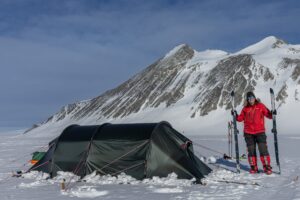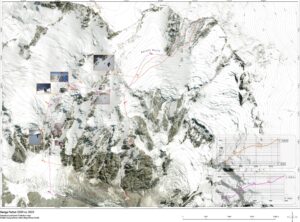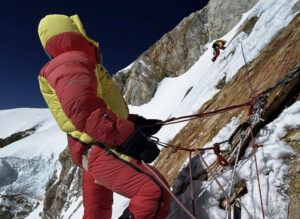Last month, Guinness World Records (GWR) kicked up a media storm when it decided to alter the record books and relegate Reinhold Messner’s achievement of being the first person to climb all the 8,000m peaks to that of a “legacy” record. Based on extensive research on summit topography by the expert team at 8000ers.com, Guinness now states that the first person to summit all of them was American Ed Viesturs.
Guinness has never held much sway in the mountaineering world, and Viesturs himself dismissed the record change as “ridiculous.” So did much of the wider climbing community. But for the general public, achievements from Messner and many others climbing luminaries have now been thrown into doubt.
Historically, Guinness has done a reasonable job at cataloguing major exploration records, such as the first to climb notable mountains, cross deserts, or ski to the Poles. But in recent years, as guided adventure tourism has allowed relative beginners to take on more extreme challenges, the record chronicling organization has begun rubber stamping an endless number of adventure records, many of which are tenuous and contrived.
See, for example, the fastest ascent of the top three highest mountains with supplementary oxygen (female) or fastest time to climb the Seven Summits and ski the polar last degrees (male).
When did the contrived records begin?
Before changing its name to Guinness World Records, the organization began as the Guinness Book of Records from 1955-1999, with a primary focus on its famous reference book. Over the years, GWR has become an international franchise that is considered the global authority for chronicling and verifying world records of the human and natural world, as well as creating museums and even television series.
In 2008, the franchise was bought out by the Jim Pattison Group, which also owns the Ripley’s Believe It or Not! museums. Some media sources have suggested that since 2008, GWR has moved its business model toward helping individuals and companies create records to garner attention, while the company generates income via a consulting fee for would-be record breakers.

The Guinness World Records Museum, Copenhagen. Photo: Ash Routen
Seven Summits
It’s hard to pinpoint exactly when the rash of contrived adventure records linked to Guinness started, but it may have its roots in the wider commodification of adventure. In the 1980s, American businessman Dick Bass dreamed up and completed the Seven Summits. Bass’s quest helped kick-start commercial guiding of rich amateurs on major peaks such as Everest and Mt. Vinson in Antarctica.
A decade later, British businessman David Hempleman-Adams ushered in the era of the Explorers Grand Slam in 1998. These listicle records were at the time considered second best to a true polar first or an unclimbed line on a Himalayan wall, but they were still thought of as significant challenges.
In hindsight, however, they were a means for adventurers to create a record and a claim of originality that may have paved the way for feats that included increasing numbers of qualifiers. This became common in the early noughts e.g. Fastest time to climb the Seven Summits (both lists) by a married couple.
Looking back at early versions of the Guinness Book of Records, you can find references to adventure and exploration. For example, in the 1984 edition, Ranulph Fiennes was rather grandiosely proclaimed as “the greatest living explorer.” And the 1985 edition (see below) details key mountaineering records on major peaks such as Everest.

The 1985 Guinness Book of Records.
Not a mountaineering authority
Historically though, Guinness was never a reference for serious mountaineers. Instead, preference was placed on The Himalayan Database or nowadays, 8000ers.com. Yet in the last five to ten years, mountaineering — particularly on the 8,000m peaks — has become infested with contrived records by commercial climbers. It could be argued that climbers such as Nirmal Purja and his 14×8,000m speed record, and the associated glut of GWR certificates, started this trend. See for example his record for the “fastest triple header of 3x8000m peaks.”
Himalayan outfitters have latched onto this, and both Sherpas and guided clients have ticked off everything from the youngest female to climb Everest and K2 to the most ascents of Makalu in a season.
It’s not just mountaineering and polar travel that are affected. In 2010, British TV presenter Helen Skelton broke the Guinness World Record for the longest distance kayaked by a woman in 24 hours (75 miles). Seasoned kayakers dismissed this claim as a “long training run,” and Katie Pfefferkorn-Mansker promptly more than doubled the distance in the same year.
Get famous-quick-adventurers
Many adventurers now clamor for their own framed GWR certificate, in the hope it will lead to greater publicity. These are ready-baked for the Instagram generation of heavily guided climbers or polar skiers to wave aloft. If you can dream up a record, Guinness will likely endorse it, as long as you can prove you did it. This is a problem for several reasons. First, it creates the perfect conditions for get-famous-quick adventurers.
That is someone who is a relative beginner in his or her discipline and who targets a record — usually low-hanging fruit that has not been previously attempted often, if at all. Typically, they get a lot of guided help. The more canny marketers are able to leverage significant publicity for commercial gain. Rarely do the guides get much credit. Often, this diminishes the credit of those adventurers who are truly on the cutting edge. This happened with Borge Ousland after Colin O’Brady’s partial crossing of Antarctica.
Unfortunately, the growing focus on creating shallow records for those preoccupied with marketing their originality, no matter how diluted with qualifiers, overshadows the real value of adventurous experiences. These include personal growth, scientific or geographic learning, rarely-seen imagery, cultural accounts, and the simple joy of traveling through sublime natural landscapes.

An adventure tourist at the ceremonial South Pole. Photo: ALE
Outfitters’ business model
This model of record-generating is unlikely to vanish any time soon. Outfitters and logistics operators have begun using it as part of their business model. They often tantalize potential clients by pointing out which records they have a chance to break. While they are not all Guinness records, the influence of Guinness has arguably promoted the wider practice of creating records with increasing numbers of qualifiers (youngest, of certain ethnicity, gender, or nationality).
For example, when independent traveler Anja Blacha (who is not a get-famous-quick type) completed a solo unsupported ski expedition from Berkner Island to the South Pole in Antarctica in 2020, her certification letter from Antarctic Logistics and Expeditions (ALE) listed no more than seven potential records, including “the first woman under 30 to ski solo, unsupported, & unassisted to the South Pole.”
Records beget business for adventure outfitters, and the attention the record-setters get inspires others to get out their magnifying glasses to hunt for even more obscure records.
A good example of this symbiotic relationship between outfitter and record pursuer is controversial adventurer Colin O’Brady, who was drawn in by ALE with the prospect of a world first in Antarctica in 2018. In subsequent years (and this coming season), further adventurers have targeted similar partial crossings of Antarctica. This includes Preet Chandi: Despite a solid effort, she fell just short of a partial crossing last season but bagged a number of largely irrelevant Guinness World Records in the process.

Shishapangma from near Base Camp. Photo: Sasko Kedev
Ethical issues
Some more ethically focused issues are also worth considering. The pursuit of a world record can lead to unhealthy competition. In recent weeks, we have seen the argument that competition to become the first American woman to climb the 8000’ers may have contributed to the deaths of four climbers on Shishapangma, the world’s fourteenth-highest mountain. Likewise, there are many other examples of climbers risking “hair-raising conditions” to keep pace for a speed record — see Kristin Harila’s 2022 Manaslu climb, for example.
The pursuit of these speed records in the high mountains also comes at an environmental cost. Both Nirmal Purja and Kristin Harila used helicopters to speed between base camps, as well as ferry equipment higher up the mountain. This practice runs in stark contrast to environmental principles for many in the adventure community.
Slipping past fact-checkers
In 2018, Polish adventurer Marcin Gienieczko claimed to have completed a 5,986km solo canoe descent of the Amazon. Gienieczko said he completed it alone in an open canoe. Guinness quickly certified Gienieczko’s expedition as the “Longest Journey by Canoe (Kayak) Solo.”
A subsequent investigation by Canoe & Kayak revealed that it was not the longest, nor was it solo. Gienieczko caught a ride on a motorized boat and forced his Peruvian fixer to paddle hundreds of kilometers with him, according to the magazine. In addition, several adventurers have paddled a great deal farther solo.
It’s clearly hard for Guinness to keep up with the minutia of all the sub-disciplines of adventure, and some false or dubious records are bound to slip through the net. Recently, Guinness has partnered with experts for more robust record adjudication. For polar records, they work with the Polar Expeditions Classification Scheme (PECS), and for mountaineering, they consult mountain chronicler Eberhard Jurgalski of 8000ers.com.
Even these consultations are not infallible, though. Guinness used Jurgalski’s excellent work to tarnish Reinhold Messner while handing out tenuous climbing records like confetti to commercial climbers. And while PECS started precisely to ensure consistency on polar record claims, it still allows some hair-splitting “records.” It could also face conflict-of-interest accusations since at least one of its members also works for Antarctic Logistics and Expeditions.
Enduring prestige
For the general public, Guinness records still carry prestige. Flash one of their certificates in a corporate meeting and you may score funding for your next adventure, even if you can’t put on your own crampons without help. Flash one of their certificates to the press and you might make it into your country’s national newspaper.
But if the adventure community continues to encourage Guinness to legitimize contrived records, public skepticism will grow and interest will diminish. That may have consequences for those who seek to make a living from their passion, through guiding, speaking, photography and film, or journalism. Like the boy who cried wolf, who will be left to listen?
Stick to gimmicks

Steve Kueny paddles a 500kg pumpkin boat down the Missouri River. He paddled more than 61km, setting a new (to be verified) Guinness record. Photo: Nathan Warson
Many of us seek adventure for deeply personal reasons. Concepts like style, difficulty, and the connection with nature matter most. They certainly trump the external validation of a dubious first. The adventure community should consider if they want the very same organization that hands out absurd records to wacky dictators such as Gurbanguly Berdimuhamedov (skip to 12:30), to preside in any way over the annals of adventure. Perhaps Guinness is better left sticking to what first made it so charming, overseeing gimmick records by, for example, those who paddle a giant pumpkin boat.
Full disclosure
In 2015, I took part in a GWR attempt for the most people bouncing on trampolines at the same time. It was fun and we may have held the record for a short time.





